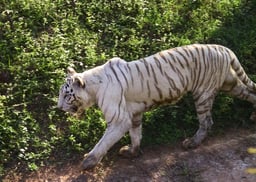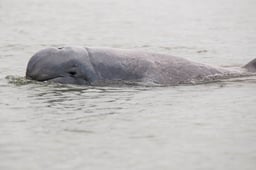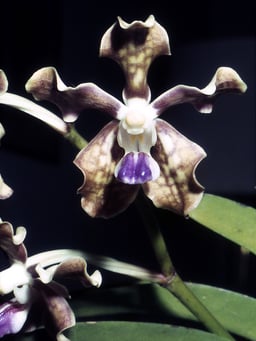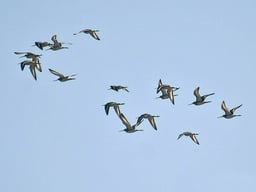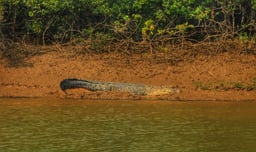Odisha
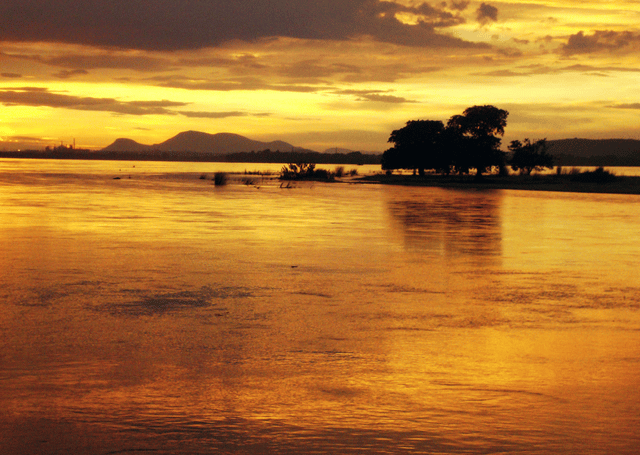
Odisha

Odisha Kalinga, Utkal | |
|---|---|
State | |
| Odisha | |
Clockwise from top: Jagannath Temple, Puri, Chilka Lake, Mahanadi river, Sun Temple of Konarka, Udayagiri and Khandagiri Jain Caves | |
 | |
| Coordinates (Bhubaneswar):20°16′N 85°49′E [127] | |
| Country | |
| Statehood | 1 April 1936 (Utkala Dibasa) |
| Capital | Bhubaneswar |
| Largest city | Bhubaneswar[1] |
| Districts | ****30 |
| Government | |
| • Body | Government of Odisha |
| • Governor | Ganeshi Lal[2] |
| • Chief Minister | Naveen Patnaik (BJD) |
| • Legislature | Unicameral (147 seats) |
| • Parliamentary constituency | 21 Lok Sabha; 10 Rajya Sabha[3] |
| • High Court | Orissa High Court, Cuttack, Odisha |
| Area | |
| • Total | 155,707 km2(60,119 sq mi) |
| Area rank | 8th |
| Population (2018) | |
| • Total | 45,989,232 |
| • Rank | 11th |
| • Density | 300/km2(760/sq mi) |
| Demonym(s) | Odia |
| GDP(2017–18) | |
| • Total | ₹4.16 lakh crore(US$60 billion) |
| • Per capita | ₹80,991(US$1,200) |
| Time zone | UTC+05:30 (IST) |
| ISO 3166 code | IN-OR |
| HDI | |
| HDI rank | 25th (2015) |
| Literacy | 73.45%[6] |
| Official language | Odia[7] |
| Website | www.odisha.gov.in [128] |
| Symbols of Odisha | |
| Flag | Indian |
| Emblem | Konark Horse |
| Language | Odia |
| Song | Bande Utkala Janani |
| Dance | Odissi |
| Animal | Sambar |
| Bird | PeacockMayura(ମୟୂର) |
| Flower | Ashoka |
| Tree | Indian Fig tree |
| Sweet | Rasagola |
Odisha (/əˈdɪsə/,[8] /ɒˈrɪsə, ɔː-, oʊ-/;,[9] pronounced [oɽɪˈsaː] (listen); formerly known as Orissa) is one of the 29 states of India. Located in south-eastern India, it is surrounded by the states of West Bengal to the northeast, Jharkhand to the north, Chhattisgarh to the west and northwest, and Andhra Pradesh to the south. Odisha has 485 kilometres (301 mi) of coastline along the Bay of Bengal on its east, from Balasore to Ganjam.[10] It is the 8th largest state by area, and the 11th largest by population. The state also has the third largest population of Scheduled Tribes in India.[11] Odia[12] is the official and most widely spoken language, spoken by 36.6 million according to the 2016 Census.[13]
The ancient kingdom of Kalinga, which was invaded by the Mauryan emperor Ashoka in 261 BCE resulting in the Kalinga War, coincides with the borders of modern-day Odisha.[14] The modern state of Odisha was established on 1 April 1936, as a province in British India, and consisted predominantly of Odia-speaking regions.[14] 1 April is celebrated as Utkala Dibasa.[15] The region is also known as Utkala and is mentioned in India's national anthem, "Jana Gana Mana".[16] Cuttack was made the capital of the region by Anantavarman Chodaganga in c. 1135,[17] after which the city was used as the capital by many rulers, through the British era until 1948. Thereafter, Bhubaneswar became the capital of Odisha.[18]
The economy of Odisha is the 16th-largest state economy in India with ₹4.16 lakh crore (US$60 billion) in gross domestic product and a per capita GDP of ₹81,000 (US$1,200).[4] Odisha ranks 25th among Indian states in human development index.[5]
Odisha Kalinga, Utkal | |
|---|---|
State | |
| Odisha | |
Clockwise from top: Jagannath Temple, Puri, Chilka Lake, Mahanadi river, Sun Temple of Konarka, Udayagiri and Khandagiri Jain Caves | |
 | |
| Coordinates (Bhubaneswar):20°16′N 85°49′E [127] | |
| Country | |
| Statehood | 1 April 1936 (Utkala Dibasa) |
| Capital | Bhubaneswar |
| Largest city | Bhubaneswar[1] |
| Districts | ****30 |
| Government | |
| • Body | Government of Odisha |
| • Governor | Ganeshi Lal[2] |
| • Chief Minister | Naveen Patnaik (BJD) |
| • Legislature | Unicameral (147 seats) |
| • Parliamentary constituency | 21 Lok Sabha; 10 Rajya Sabha[3] |
| • High Court | Orissa High Court, Cuttack, Odisha |
| Area | |
| • Total | 155,707 km2(60,119 sq mi) |
| Area rank | 8th |
| Population (2018) | |
| • Total | 45,989,232 |
| • Rank | 11th |
| • Density | 300/km2(760/sq mi) |
| Demonym(s) | Odia |
| GDP(2017–18) | |
| • Total | ₹4.16 lakh crore(US$60 billion) |
| • Per capita | ₹80,991(US$1,200) |
| Time zone | UTC+05:30 (IST) |
| ISO 3166 code | IN-OR |
| HDI | |
| HDI rank | 25th (2015) |
| Literacy | 73.45%[6] |
| Official language | Odia[7] |
| Website | www.odisha.gov.in [128] |
| Symbols of Odisha | |
| Flag | Indian |
| Emblem | Konark Horse |
| Language | Odia |
| Song | Bande Utkala Janani |
| Dance | Odissi |
| Animal | Sambar |
| Bird | PeacockMayura(ମୟୂର) |
| Flower | Ashoka |
| Tree | Indian Fig tree |
| Sweet | Rasagola |
Etymology
The term "Odisha" is derived from the ancient Prakrit word "Odda Visaya" (also "Udra Bibhasha" or "Odra Bibhasha") as in the Tirumalai inscription of Rajendra Chola I, which is dated to 1025.[19] Sarala Das, who translated the Mahabharata into the Odia language in the 15th century, calls the region 'Odra Rashtra' as Odisha. The inscriptions of Kapilendra Deva of the Gajapati Kingdom (1435–67) on the walls of temples in Puri call the region Odisha or Odisha Rajya.[20]
The name of the state was changed from Orissa to Odisha, and the name of its language from Oriya to Odia, in 2011, by the passage of the Orissa (Alteration of Name) Bill, 2010 and the Constitution (113th Amendment) Bill, 2010 in the Parliament. After a brief debate, the lower house, Lok Sabha, passed the bill and amendment on 9 November 2010.[21] On 24 March 2011, Rajya Sabha, the upper house of Parliament, also passed the bill and the amendment.[22]
History

Lingaraja Temple built by the Somavanshi king Jajati Keshari
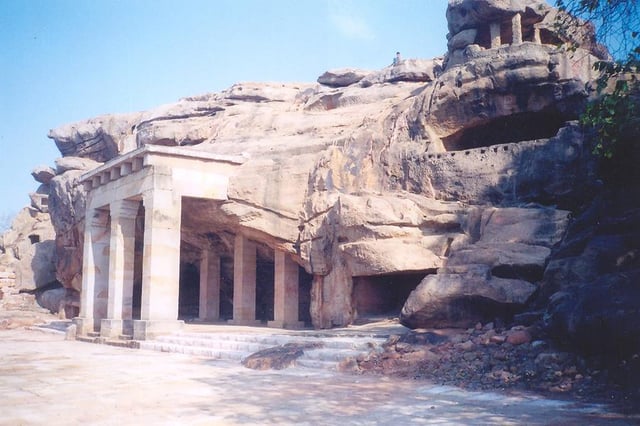
Hathigumpha on the Udayagiri Hills built in c. 150 BCE

Shanti Stupa at Dhauli is the location where Kalinga War was fought in c. 260 BCE
Prehistoric Acheulian tools dating to Lower Paleolithic era have been discovered in various places in the region, implying an early settlement by humans.[23] Kalinga has been mentioned in ancient texts like Mahabharata, Vayu Purana and Mahagovinda Suttanta.[24][25] The Sabar people of Odisha have also been mentioned in the Mahabharata.[26][27] Baudhayana mentions Kalinga as not yet being influenced by Vedic traditions, implying it followed mostly tribal traditions.[28]
Ashoka of the Mauryan dynasty conquered Kalinga in the bloody Kalinga War in 261 BCE,[29] which was the eighth year of his reign.[30] According to his own edicts, in that war about 100,000 people were killed, 150,000 were captured and more were affected.[29] The resulting bloodshed and suffering of the war is said to have deeply affected Ashoka. He turned into a pacifist and converted to Buddhism.[30][31]
By c. 150 BCE, emperor Kharavela, who was possibly a contemporary of Demetrius I of Bactria,[32] conquered a major part of the Indian sub-continent. Kharavela was a Jain ruler. He also built the monastery atop the Udayagiri hill.[33] Subsequently, the region was ruled by monarchs, such as Samudragupta[34] and Shashanka.[35] It was also a part of Harsha's empire.[36]
Later, the kings of the Somavamsi dynasty began to unite the region. By the reign of Yayati II, c. 1025 CE, they had integrated the region into a single kingdom. Yayati II is supposed to have built the Lingaraj temple at Bhubaneswar.[14] They were replaced by the Eastern Ganga dynasty. Notable rulers of the dynasty were Anantavarman Chodaganga, who began re-construction on the present-day Shri Jagannath Temple in Puri (c. 1135), and Narasimhadeva I, who constructed the Konark temple (c. 1250).[37][38]
The Eastern Ganga Dynasty was followed by the Gajapati Kingdom. The region resisted integration into the Mughal empire until 1568, when it was conquered by Sultanate of Bengal.[39] Mukunda Deva, who is considered the last independent king of Kalinga, was defeated and was killed in battle by a rebel Ramachandra Bhanja. Ramachandra Bhanja himself was killed by Bayazid Khan Karrani.[40] In 1591, Man Singh I, then governor of Bihar, led an army to take Odisha from the Karranis of Bengal. They agreed to treaty because their leader Qutlu Khan Lohani had recently died. But, they then broke the treaty by attacking the temple town of Puri. Man Singh returned in 1592 and pacified the region.[41]
In 1751, the Nawab of Bengal Alivardi Khan ceded the region to the Maratha Empire.[14]
The British had occupied the Northern Circars, comprising the southern coast of Odisha, as a result of the 2nd Carnatic War by 1760, and incorporated them into the Madras Presidency gradually.[42] In 1803, the British ousted the Marathas from the Puri-Cuttack region of Odisha during the Second Anglo-Maratha War. The northern and western districts of Odisha were incorporated into the Bengal Presidency.[43]
The Orissa famine of 1866 caused an estimated 1 million deaths.[44] Following this, large-scale irrigation projects were undertaken.[45] There was a view among some sections of population that Odia was not a separate language rather a dialect of Bengali.This view ultimately precipitated Odia nationalism.[46] In 1903, the Utkal Sammilani organisation was founded to demand the unification of Odia-speaking regions into one state.[47] On 1 April 1912, the Bihar and Orissa Province was formed.[48] On 1 April 1936, Bihar and Orissa were split into separate provinces.[49] The new province of Orissa came into existence on a linguistic basis during the British rule in India, with Sir John Austen Hubback as the first governor.[49][50] Following India's independence, on 15 August 1947, 27 princely states signed the document to join Orissa.[51]
Geography
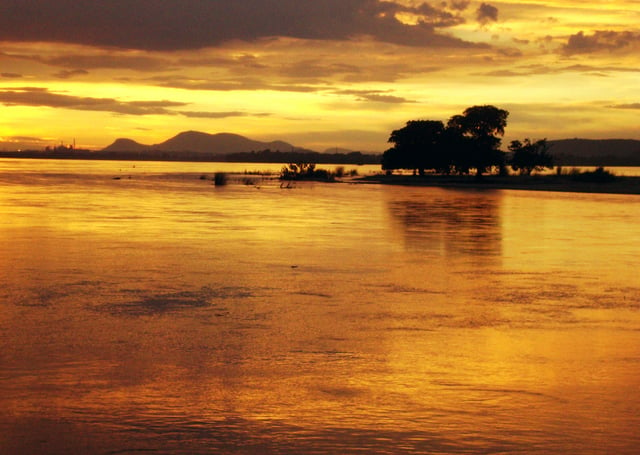
Mahanadi river near Cuttack
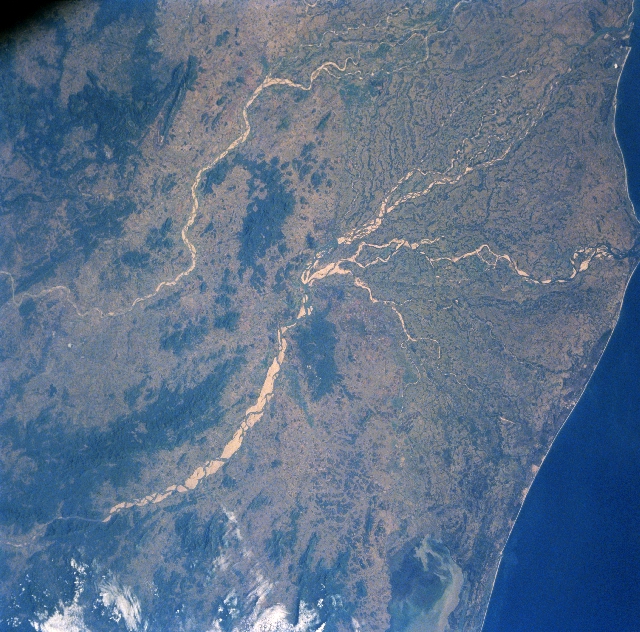
Satellite view of the Mahanadi river delta
Odisha lies between the latitudes 17.780N and 22.730N, and between longitudes 81.37E and 87.53E. The state has an area of 155,707 km2, which is 4.87% of total area of India, and a coastline of 450 km.[52] In the eastern part of the state lies the coastal plain. It extends from the Subarnarekha River in the north to the Rushikulya river in the south. The lake Chilika is part of the coastal plains. The plains are rich in fertile silt deposited by the six major rivers flowing into the Bay of Bengal: Subarnarekha, Budhabalanga, Baitarani, Brahmani, Mahanadi and Rushikulya.[52] The Central Rice Research Institute (CRRI), a Food and Agriculture Organization-recognised rice gene bank and research institute, is situated on the banks of Mahanadi in Cuttack.[53]
Three-quarters of the state is covered in mountain ranges. Deep and broad valleys have been made in them by rivers. These valleys have fertile soil and are densely populated. Odisha also has plateaus and rolling uplands, which have lower elevation than the plateaus.[52] The highest point in the state is Deomali at 1,672 metres. The other high peaks are: Sinkaram (1,620 m), Golikoda (1,617 m), and Yendrika (1,582 metres).[54]
Climate
The state experiences four meteorological seasons: winter (January to February), pre-monsoon season (March to May), south-west monsoon season (June to September) and north east monsoon season (October–December). However, locally the year is divided into six traditional seasons (or rutus): Grishma (summer), Barsha (rainy season), Sharata (autumn), Hemanta (winter),Sheeta(cool season) and Basanta (spring), .[52]
| Mean Temp and Precipitation of Selected Weather Stations[55] | ||||||||||||
|---|---|---|---|---|---|---|---|---|---|---|---|---|
| Bhubaneswar (1952–2000) | Balasore (1901–2000) | Gopalpur (1901–2000) | Sambalpur (1901–2000) | |||||||||
| Max (C) | Min (C) | Rainfall (mm) | Max (C) | Min (C) | Rainfall (mm) | Max (C) | Min (C) | Rainfall (mm) | Max (C) | Min (C) | Rainfall (mm) | |
| January | 28.5 | 15.5 | 13.1 | 27.0 | 13.9 | 17.0 | 27.2 | 16.9 | 11.0 | 27.6 | 12.6 | 14.2 |
| February | 31.6 | 18.6 | 25.5 | 29.5 | 16.7 | 36.3 | 28.9 | 19.5 | 23.6 | 30.1 | 15.1 | 28.0 |
| March | 35.1 | 22.3 | 25.2 | 33.7 | 21.0 | 39.4 | 30.7 | 22.6 | 18.1 | 35.0 | 19.0 | 20.9 |
| April | 37.2 | 25.1 | 30.8 | 36.0 | 24.4 | 54.8 | 31.2 | 25.0 | 20.3 | 39.3 | 23.5 | 14.2 |
| May | 37.5 | 26.5 | 68.2 | 36.1 | 26.0 | 108.6 | 32.4 | 26.7 | 53.8 | 41.4 | 27.0 | 22.7 |
| June | 35.2 | 26.1 | 204.9 | 34.2 | 26.2 | 233.4 | 32.3 | 26.8 | 138.1 | 36.9 | 26.7 | 218.9 |
| July | 32.0 | 25.2 | 326.2 | 31.8 | 25.8 | 297.9 | 31.0 | 26.1 | 174.6 | 31.1 | 24.9 | 459.0 |
| August | 31.6 | 25.1 | 366.8 | 31.4 | 25.8 | 318.3 | 31.2 | 25.9 | 195.9 | 30.7 | 24.8 | 487.5 |
| September | 31.9 | 24.8 | 256.3 | 31.7 | 25.5 | 275.8 | 31.7 | 25.7 | 192.0 | 31.7 | 24.6 | 243.5 |
| October | 31.7 | 23.0 | 190.7 | 31.3 | 23.0 | 184.0 | 31.4 | 23.8 | 237.8 | 31.7 | 21.8 | 56.6 |
| November | 30.2 | 18.8 | 41.7 | 29.2 | 17.8 | 41.6 | 29.5 | 19.7 | 95.3 | 29.4 | 16.2 | 17.6 |
| December | 28.3 | 15.2 | 4.9 | 26.9 | 13.7 | 6.5 | 27.4 | 16.4 | 11.4 | 27.2 | 12.1 | 4.8 |
Biodiversity
According to a Forest Survey of India report released in 2012, Odisha has 48,903 km2 of forests which cover 31.41% of the state's total area. The forests are classified into: dense forest (7,060 km2), medium dense forest (21,366 km2), open forest (forest without closed canopy; 20,477 km2) and scrub forest (4,734 km2). The state also has bamboo forests (10,518 km2) and mangroves (221 km2). The state is losing its forests to timber smuggling, mining, industrialisation and grazing. There have been attempts at conservation and reforestation.[56]
Due to the climate and good rainfall, Odisha's evergreen and moist forests are suitable habitats for wild orchids. Around 130 species have been reported from the state.[57] 97 of them are found in Mayurbhanj district alone. The Orchid House of Nandakanan Biological Park hosts some of these species.[58]
Simlipal National Park is a protected wildlife area and tiger reserve spread over 2,750 km2 of the northern part of Mayurbhanj district. It has 1078 species of plants, including 94 orchids. The sal tree is the primary tree species there. The park has 55 mammals, including barking deer, Bengal tiger, common langur, four-horned antelope, Indian bison, Indian elephant, Indian giant squirrel, Indian leopard, jungle cat, sambar deer, and wild boar. There are 304 species of birds in the park, such as the common hill myna, grey hornbill, Indian pied hornbill and Malabar pied hornbill. It also has 60 species of reptiles, notable among which are the king cobra and tricarinate hill turtle. There is also a mugger crocodile breeding program in nearby Ramtirtha.[59] The Chandaka Elephant Sanctuary is a 190 km2 protected area near the capital city, Bhubaneswar. However, urban expansion and over-grazing have reduced the forests and are driving herds of elephants to migration. In 2002, there were about 80 elephants. But by 2012, their numbers had been reduced to 20. Many of the animals have migrated toward the Barbara reserve forest, Chilika, Nayagarh district, and Athagad. Some elephants have died in conflicts with villagers, while some have died during migration from being electrocuted by power lines or hit by trains. Outside the protected area, they are killed by poachers.[60][61] Besides elephants, the sanctuary also has Indian leopards, jungle cats and chitals.[62]
The Bhitarkanika National Park in Kendrapara District covers 650 km2, of which 150 km2 are mangroves. The Gahiramatha beach in Bhitarkanika is the world's largest nesting site for olive ridley sea turtles.[63] Other major nesting grounds for the turtle in the state are Rushikulya, in Ganjam district,[64] and the mouth of the Devi river.[65] The Bhitarkanika sanctuary is also noted for its large population of salt-water crocodiles.[66] In winter, the sanctuary is also visited by migratory birds. Among the species of birds spotted in the sanctuary are the black-crowned night heron, darter, grey heron, Indian cormorant, Oriental white ibis, purple heron, and sarus crane.[67] The possibly endangered horseshoe crab is also found in this region.[68]
Chilika Lake is a brackish water lagoon on the east coast of Odisha with an area of 1,105 km2. It is connected to the Bay of Bengal by a 35-km-long narrow channel and is a part of the Mahanadi delta. In the dry season, the tides bring in salt water. In the rainy season, the rivers falling into the lagoon decrease its salinity.[69] Birds from places like the Caspian Sea, Lake Baikal, other parts of Russia, Central Asia, South-East Asia, Ladakh and the Himalayas migrate to the lagoon in winter.[70] Among the birds spotted there are Eurasian wigeon, pintail, bar-headed goose, greylag goose, flamingo, mallard and Goliath heron.[71][72] The lagoon also has a small population of the endangered Irrawaddy dolphins.[73] The state's coastal region has also had sightings of finless porpoise, bottlenose dolphin, humpback dolphin and spinner dolphin in its waters.[74]
Satapada is situated close to the northeast cape of Chilika Lake and Bay of Bengal. It is famous for dolphin watching in their natural habitat. There is a tiny island en-route for watching dolphins, where tourists often take a short stop. Apart from that, this island is also home for tiny red crabs.
Government and politics
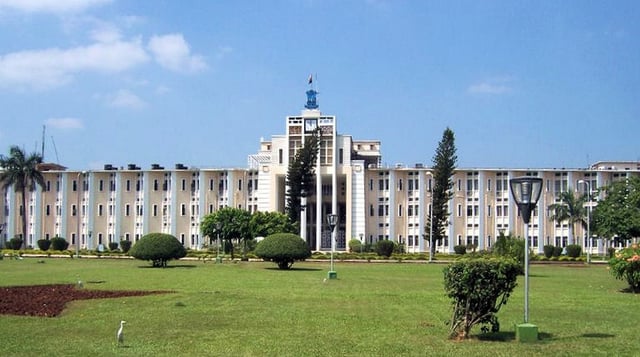
Odisha State Secretariat building in Bhubaneswar
All states in India are governed by a parliamentary system of government based on universal adult franchise.[76]
The main parties active in the politics of Odisha are the Biju Janata Dal, the Indian National Congress and Bhartiya Janata Party. Following the Odisha State Assembly Election in 2014, the Naveen Patnaik-led Biju Janata Dal stayed in power for the fifth consecutive term.[77]
Legislative assembly
The Odisha state has a unicameral legislature.[78] The Odisha Legislative Assembly consists of 147 elected members,[77] and special office bearers such as the Speaker and Deputy Speaker, who are elected by the members. Assembly meetings are presided over by the Speaker, or by the Deputy Speaker in the Speaker's absence.[79] Executive authority is vested in the Council of Ministers headed by the Chief Minister, although the titular head of government is the Governor of Odisha. The governor is appointed by the President of India. The leader of the party or coalition with a majority in the Legislative Assembly is appointed as the Chief Minister by the governor, and the Council of Ministers are appointed by the governor on the advice of the Chief Minister. The Council of Ministers reports to the Legislative Assembly.[80] The 147 elected representatives are called Members of the Legislative Assembly, or MLAs. One MLA may be nominated from the Anglo-Indian community by the governor.[81] The term of the office is for five years, unless the Assembly is dissolved prior to the completion of the term.[79]
The judiciary is composed of the Odisha High Court, located at Cuttack, and a system of lower courts.
Subdivisions

Map of districts of Odisha
Odisha Has been divided into 30 districts. These 30 districts have been placed under three different revenue divisions to streamline their governance. The divisions are North, South and Central, with their headquarters at Sambalpur, Berhampur and Cuttack respectively. Each division consists of ten districts, and has as its administrative head a Revenue Divisional Commissioner (RDC).[82] The position of the RDC in the administrative hierarchy is that between that of the district administration and the state secretariat.[83] The RDCs report to the Board of Revenue, which is headed by a senior officer of the Indian Administrative Service.[82]
| Northern Division (HQ – Sambalpur) | Central Division (HQ – Cuttack) | Southern Division (HQ – Berhampur) |
|---|---|---|
|
|
|
Each district is governed by a Collector and District Magistrate, who is appointed from the Indian Administrative Service.[85][86] The Collector and District Magistrate is responsible for collecting the revenue and maintaining law and order in the district. Each District is separated into Sub-Divisions, each governed by a Sub-Collector and Sub-Divisional Magistrate. The Sub-Divisions are further divided into Tahasils. The Tahasils are headed by Tahasildar. Odisha has 58 Sub-Divisions, 317 Tahasils and 314 Blocks.[84] Blocks consists of Panchayats (village councils) and town municipalities.
The capital and largest city of the state is Bhubaneswar. The other major cities are Cuttack, Rourkela, Berhampur and Sambalpur. Municipal Corporations in Odisha include Bhubaneswar, Cuttack, Berhampur, Sambalpur and Rourkela.
Other municipalities of Odisha include Angul, Balangir, Balasore, Barbil, Bargarh, Baripada, Belpahar, Bhadrak, Bhawanipatna, Biramitrapur, Boudh, Byasanagar, Chhatrapur, Deogarh, Dhenkanal, Gopalpur, Gunupur, hinjilicut, Jagatsinghpur, Jajpur, Jeypore, Jharsuguda, Joda, Kendrapara, Kendujhar, Khordha, Konark, Koraput, Malkangiri, Nabarangpur, Nayagarh, Nuapada, Paradeep, Paralakhemundi, Phulbani, Puri, Rajgangpur, Rayagada, Sonepur, Sundargarh, Talcher and Umerkote.
Auxiliary authorities known as panchayats, for which local body elections are regularly held, govern local affairs in rural areas.
Economy
Macro-economic trend
Odisha is experiencing steady economic growth. The impressive growth in gross domestic product of the state has been reported by the Ministry of Statistics and Programme Implementation. Odisha's growth rate is above the national average.[87] The central Government's Urban Development Ministry has recently announced the names of 20 cities selected to be developed as smart cities. The state capital Bhubaneswar is the first city in the list of smart Cities released in January 2016, a pet project of the Indian Government. The announcement also marked with sanction of Rs 50,802 crore over the five years for development.[88]
Industrial development
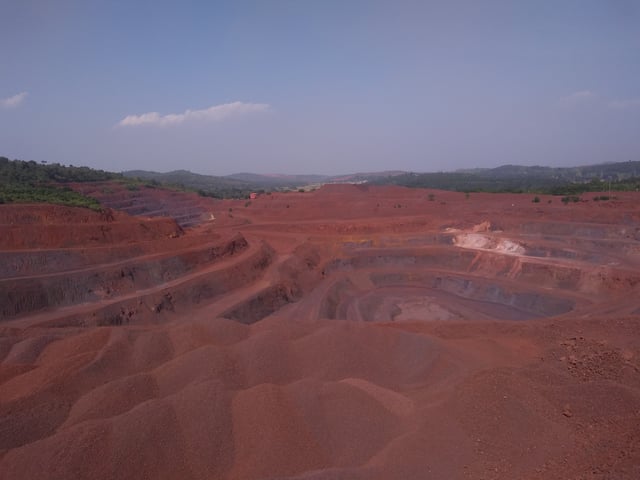
One of the iron ore mines in Keonjhar district
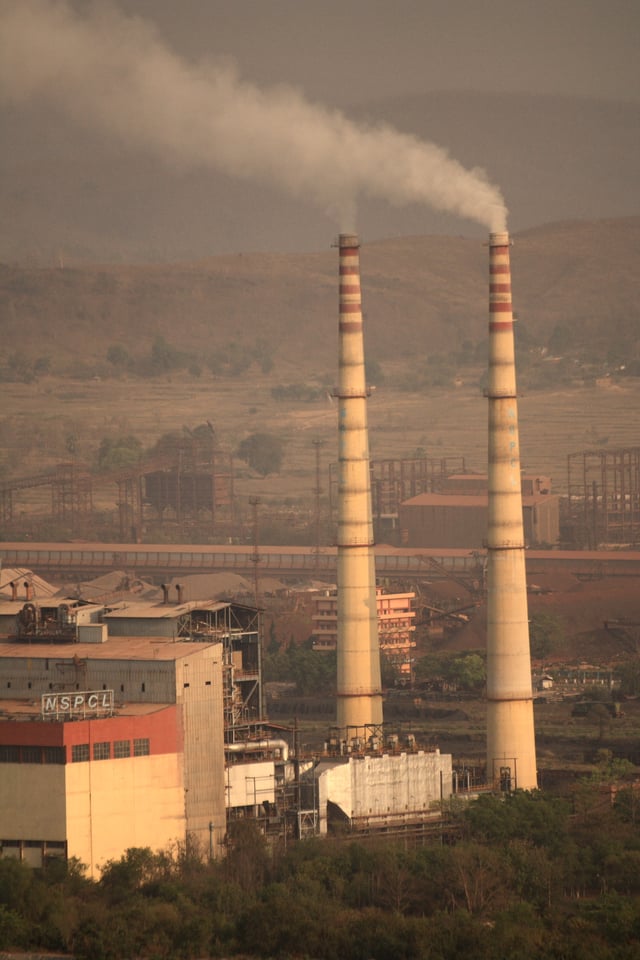
Rourkela Steel Plant
Odisha has abundant natural resources and a large coastline. Odisha has emerged as the most preferred destination for overseas investors with investment proposals.[89] It contains a fifth of India's coal, a quarter of its iron ore, a third of its bauxite reserves and most of the chromite.
Rourkela Steel Plant[90] was the first integrated steel plant in the public sector in India, built with collaboration of Germany.
Arcelor-Mittal has also announced plans to invest in another mega steel project amounting to $10 billion. Russian major Magnitogorsk Iron and Steel Company (MMK) plans to set up a 10 MT steel plant in Odisha, too. Bandhabahal is a major area of open cast coal mines in Odisha. The state is attracting an unprecedented amount of investment in aluminium, coal-based power plants, petrochemicals, and information technology as well. In power generation, Reliance Power (Anil Ambani Group) is putting up the world's largest power plant with an investment of US$13 billion at Hirma in Jharsuguda district.[91]
In 2009 Odisha was the second top domestic investment destination with Gujarat first and Andhra Pradesh in third place according to an analysis of ASSOCHAM Investment Meter (AIM) study on corporate investments. Odisha's share was 12.6 percent in total investment in the country. It received investment proposal worth ₹. 2,00,846 crore during the last year. Steel and power were among the sectors which attracted maximum investments in the state.[92]
Transportation
Air
Odisha has a total of two operational airports, 17 airstrips and 16 helipads.[95][96][97] The airport at Jharsuguda was upgraded to a full-fledged domestic airport in May 2018.[98] The government of Odisha also plans five greenfield airports at Angul, Dhamra, Kalinganagar, Paradip and Rayagada in an effort to boost intra-state and inter-state civil aviation. Existing aerodromes at Barbil, Gopalpur, Jharsuguda and Rourkela were also to be upgraded.[99] Air Odisha, is Odisha's sole air charter company based in Bhubaneswar.
Angul – Savitri Jindal Airport
Bargarh – Sativata Airstrip
Bhawanipatna – Utkela Airstrip
Bhubaneswar – Biju Patnaik International Airport
Brahmapur – Berhampur Airport
Cuttack – Charbatia Air Base
Jeypore – Jeypore Airport
Jharsuguda – Veer Surendra Sai Airport
Rourkela – Rourkela Airport
Sambalpur – Hirakud Airstrip
Seaports
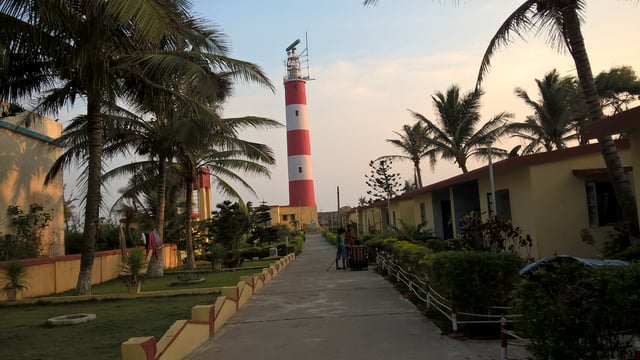
Gopalpur Port
Port of Dhamara
Port of Gopalpur
Port of Paradip
Port of Subarnarekha
Port of Astarang
Port of Chandipur
Railways
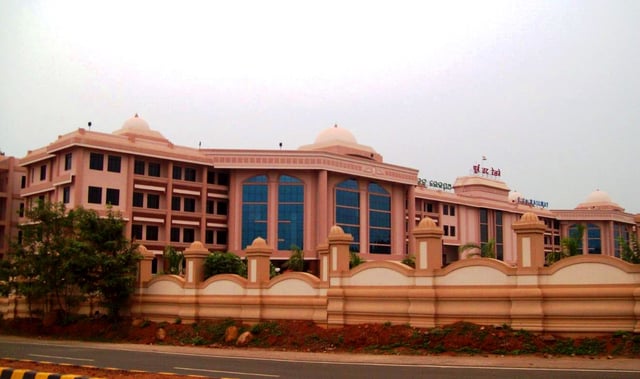
East Coast Railway headquarters, Bhubaneswar
Major cities of Odisha are well connected to all the major cities of India by direct daily trains and weekly trains. Most of the railway network in Odisha lies under the jurisdiction of the East Coast Railway (ECoR) with headquarters at Bhubaneswar and some parts under South Eastern Railway and South East Central Railway.
Demographics

Tribal people of Koraput, Odisha
| Historical population | ||
|---|---|---|
| Year | Pop. | ±% p.a. |
| 1901 | 10,302,917 | — |
| 1911 | 11,378,875 | +1.00% |
| 1921 | 11,158,586 | −0.20% |
| 1931 | 12,491,056 | +1.13% |
| 1941 | 13,767,988 | +0.98% |
| 1951 | 14,645,946 | +0.62% |
| 1961 | 17,548,846 | +1.82% |
| 1971 | 21,944,615 | +2.26% |
| 1981 | 26,370,271 | +1.85% |
| 1991 | 31,659,736 | +1.84% |
| 2001 | 36,804,660 | +1.52% |
| 2011 | 41,974,218 | +1.32% |
| source:[102] | ||
According to the 2018 census of India, the total population of Odisha is 46,143,782, of which 21,201,678 (50.54%) are male and 20,745,680 (49.46%) are female, or 978 females per 1000 males. This represents a 13.97% increase over the population in 2001. The population density is 269 per km2.
The literacy rate is 73%, with 82% of males and 64% of females being literate, according to the 2011 census.
The proportion of people living below the poverty line in 2004–2005 was 57.15% which was nearly double the Indian average of 26.10%. Since 2005 the state has reduced poverty rate dramatically by 24.6 percentage points.According to current estimate proportion of people living under poverty line was 32.6% [103][104]
Data of 1996–2001 showed the life expectancy in the state was 61.64 years, higher than the national value of years. The state has a birth rate of 23.2 per 1,000 people per year, a death rate of 9.1 per 1,000 people per year, an infant mortality rate of 65 per 1000 live birth and a maternal mortality rate of 358 per 1,000,000 live births. Odisha has a Human Development Index of 0.442 as of 2011.
| District | Headquarters | Population (2011) | Males | Females | Percentage decadal growth 2001–2011 | Sex ratio | Density (persons per km2) | Child population 0–6 years | Child sex ratio | Literacy rate | |
|---|---|---|---|---|---|---|---|---|---|---|---|
| 1 | Angul | Angul | 1,271,703 | 654,898 | 616,805 | 11.55 | 942 | 199 | 145,690 | 884 | 78.96 |
| 2 | Balangir | Balangir | 1,648,574 | 831,349 | 817,225 | 23.29 | 983 | 251 | 206,964 | 951 | 65.50 |
| 3 | Balasore | Baleswar | 2,317,419 | 1,184,371 | 1,133,048 | 14.47 | 957 | 609 | 274,432 | 941 | 80.66 |
| 4 | Bargarh | Bargarh | 1,478,833 | 748,332 | 730,501 | 9.84 | 976 | 253 | 156,185 | 946 | 75.16 |
| 5 | Bhadrak | Bhadrak | 1,506,522 | 760,591 | 745,931 | 12.95 | 981 | 601 | 176,793 | 931 | 83.25 |
| 6 | Boudh | Boudh | 439,917 | 220,993 | 218,924 | 17.82 | 991 | 142 | 59,094 | 975 | 72.51 |
| 7 | Cuttack | Cuttack | 2,618,708 | 1,339,153 | 1,279,555 | 11.87 | 955 | 666 | 251,152 | 913 | 84.20 |
| 8 | Debagarh | Debagarh | 312,164 | 158,017 | 154,147 | 13.88 | 976 | 106 | 38,621 | 917 | 73.07 |
| 9 | Dhenkanal | Dhenkanal | 1,192,948 | 612,597 | 580,351 | 11.82 | 947 | 268 | 132,647 | 870 | 79.41 |
| 10 | Gajapati | Paralakhemundi | 575,880 | 282,041 | 293,839 | 10.99 | 1,042 | 133 | 82,777 | 964 | 54.29 |
| 11 | Ganjam | Chhatrapur | 3,520,151 | 1,777,324 | 1,742,827 | 11.37 | 981 | 429 | 397,920 | 899 | 71.88 |
| 12 | Jagatsinghpur | Jagatsinghpur | 1,136,604 | 577,699 | 558,905 | 7.44 | 967 | 681 | 103,517 | 929 | 87.13 |
| 13 | Jajpur | Jajpur | 1,826,275 | 926,058 | 900,217 | 12.43 | 972 | 630 | 207,310 | 921 | 80.44 |
| 14 | Jharsuguda | Jharsuguda | 579,499 | 297,014 | 282,485 | 12.56 | 951 | 274 | 61,823 | 938 | 78.36 |
| 15 | Kalahandi | Bhawanipatna | 1,573,054 | 785,179 | 787,875 | 17.79 | 1,003 | 199 | 214,111 | 947 | 60.22 |
| 16 | Kandhamal | Phulbani | 731,952 | 359,401 | 372,551 | 12.92 | 1,037 | 91 | 106,379 | 960 | 65.12 |
| 17 | Kendrapara | Kendrapara | 1,439,891 | 717,695 | 722,196 | 10.59 | 1,006 | 545 | 153,443 | 921 | 85.93 |
| 18 | Kendujhar | Kendujhar | 1,802,777 | 907,135 | 895,642 | 15.42 | 987 | 217 | 253,418 | 957 | 69.00 |
| 19 | Khordha | Khordha | 2,246,341 | 1,166,949 | 1,079,392 | 19.65 | 925 | 799 | 222,275 | 910 | 87.51 |
| 20 | Koraput | Koraput | 1,376,934 | 677,864 | 699,070 | 16.63 | 1,031 | 156 | 215,518 | 970 | 49.87 |
| 21 | Malkangiri | Malkangiri | 612,727 | 303,913 | 308,814 | 21.53 | 1,016 | 106 | 105,636 | 979 | 49.49 |
| 22 | Mayurbhanj | Baripada | 2,513,895 | 1,253,633 | 1,260,262 | 13.06 | 1,005 | 241 | 337,757 | 952 | 63.98 |
| 23 | Nabarangapur | Nabarangpur | 1,218,762 | 604,046 | 614,716 | 18.81 | 1,018 | 230 | 201,901 | 988 | 48.20 |
| 24 | Nayagarh | Nayagarh | 962,215 | 502,194 | 460,021 | 11.30 | 916 | 247 | 101,337 | 851 | 79.17 |
| 25 | Nuapada | Nuapada | 606,490 | 300,307 | 306,183 | 14.28 | 1,020 | 157 | 84,893 | 971 | 58.20 |
| 26 | Puri | Puri | 1,697,983 | 865,209 | 832,774 | 13.00 | 963 | 488 | 164,388 | 924 | 85.37 |
| 27 | Rayagada | Rayagada | 961,959 | 469,672 | 492,287 | 15.74 | 1,048 | 136 | 141,167 | 955 | 50.88 |
| 28 | Sambalpur | Sambalpur | 1,044,410 | 529,424 | 514,986 | 12.24 | 973 | 158 | 112,946 | 931 | 76.91 |
| 29 | Subarnapur | Sonepur | 652,107 | 332,897 | 319,210 | 20.35 | 959 | 279 | 76,536 | 947 | 74.42 |
| 30 | Sundergarh | Sundergarh | 2,080,664 | 1,055,723 | 1,024,941 | 13.66 | 971 | 214 | 249,020 | 937 | 74.13 |
Religion
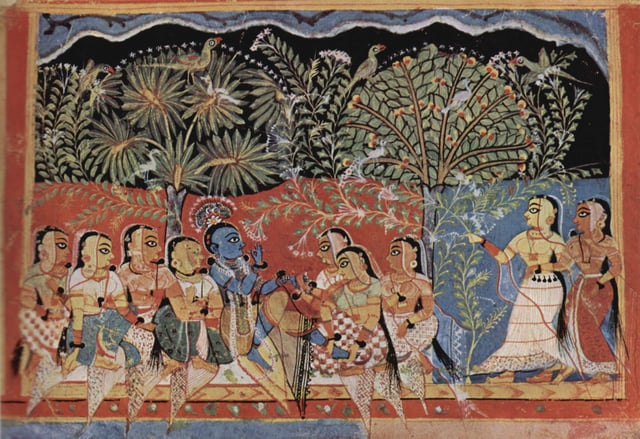
Gita Govinda
The majority (over 94%[106]) of people in the state of Odisha are Hindu and there is also a rich cultural heritage in the state. For example, Odisha is home to several Hindu figures. Sant Bhima Bhoi was a leader of the Mahima sect movement. Sarala Das, a Hindu Khandayat, was the translator of the epic Mahabharata in Odia. Chaitanya Das was a Buddhistic-Vaishnava and writer of the Nirguna Mahatmya. Jayadeva was the author of the Gita Govinda.
The Odisha Temple Authorisation Act of 1948 empowered the government of Odisha to have Hindu temples open for all Hindus including the Harijans.[107]
Perhaps the oldest scripture of Odisha is the Madala Panji from the Puri Temple believed from 1042 AD. Famous Hindu Odia scripture includes the 16th-century Bhagabata of Jagannatha Dasa.[108] In the modern times Madhusudan Rao was a major Odia writer, who was a Brahmo Samajist and shaped modern Odia literature at the start of the 20th century.[109]
Languages
Education
Educational Institutions
Indian Institute of Technology Bhubaneswar(IIT BBS) at Bhubaneswar
National Institute of Science Education and Research (NISER) at Bhubaneswar
National Institute of Technology Rourkela (NIT) at Rourkela
Indian Institute of Management (IIM-SB) at Sambalpur
Indian Institutes of Science Education and Research (IISER) at Brahmapur
All India Institute of Medical Sciences (AIIMS) at Bhubaneswar
Veer Surendra Sai University of Technology (VSSUT) at Burla
National Law University at Cuttack
International Institute of Information Technology (IIIT) at Bhubaneswar
Berhampur University at Brahmapur
Biju Patnaik University of Technology at Rourkela
Buxi Jagabandhu Bidyadhar College at Bhubaneswar
Central University of Orissa at Koraput
College of Agriculture, Bhawanipatna
College of Basic Science and Humanities at Bhubaneswar
College of Engineering and Technology at Bhubaneswar
Dharanidhar College at Keonjhar
Fakir Mohan University at Balasore
Gangadhar Meher University at Sambalpur
Government College of Engineering, Kalahandi at Bhawanipatna
Hi-Tech Medical College & Hospital, Bhubaneswar at Bhubaneswar
Indira Gandhi Institute of Technology at Sarang
KIIT University at Bhubaneswar
Khallikote University at Brahmapur
Maharaja Krishna Chandra Gajapati Medical College and Hospital at Brahmapur
National Institute of Science and Technology at Brahmapur
North Orissa University at Baripada
Odisha State Open University at Sambalpur
Orissa Engineering College at Bhubaneswar
Orissa University of Agriculture and Technology at Bhubaneswar
College of Basic Science and Humanities, Bhubaneswar
Parala Maharaja Engineering College at Brahmapur
Rama Devi Women's University at Bhubaneswar
Ravenshaw University at Cuttack
Sambalpur University at Sambalpur
Shri Ramachandra Bhanj Medical College at Cuttack
Siksha O Anusandhan University at Bhubaneswar
Utkal University at Bhubaneswar
Utkal University of Culture at Bhubaneswar
Veer Surendra Sai Medical College at Burla
Xavier Institute of Management, Bhubaneswar
Xavier University, Bhubaneswar
Institute of Mathematics and Applications, Bhubaneswar
Sri Sri University at Cuttack
Centurion University at Jatni, Bhubaneswar
National Institute of Rehabilitation Training and Research at Cuttack
National Institute of Social Work and Social Science, Bhubaneswar (NISWASS)
Pandit Raghunath Murmu Medical College and Hospital, Baripada [112]
Saheed Laxman Nayak Medical College and Hospital, Koraput [113]
Entry to various institutes of higher education especially into engineering degrees is through a centralised Odisha Joint Entrance Examination, conducted by the Biju Patnaik University of Technology (BPUT), Rourkela, since 2003, where seats are provided according to order of merit.[114] Few of the engineering institutes enroll students by through Joint Entrance Examination. For medical courses, there is a corresponding All India Pre Medical Test.
Culture
Cuisine
Dance
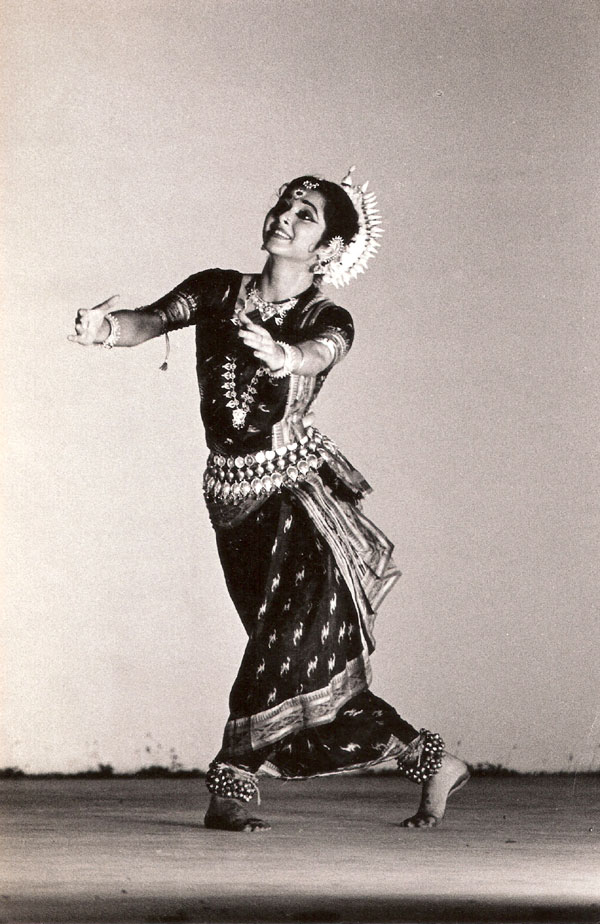
Odissi (Orissi) dance and music are classical art forms. Odissi is the oldest surviving dance form in India on the basis of archaeological evidence.[119] Odissi has a long, unbroken tradition of 2,000 years, and finds mention in the Natyashastra of Bharatamuni, possibly written c. 200 BC. However, the dance form nearly became extinct during the British period, only to be revived after India's independence by a few gurus.
The variety of dances includes Ghumura Dance, Chhau dance, Jhumair, Mahari dance, Dalkhai and Gotipua.
Sports
The state of Odisha has hosted several international sporting events, including the 2018 Men's Hockey World Cup, and will host matches for the 2020 FIFA U-17 Women's World Cup.
Tourism
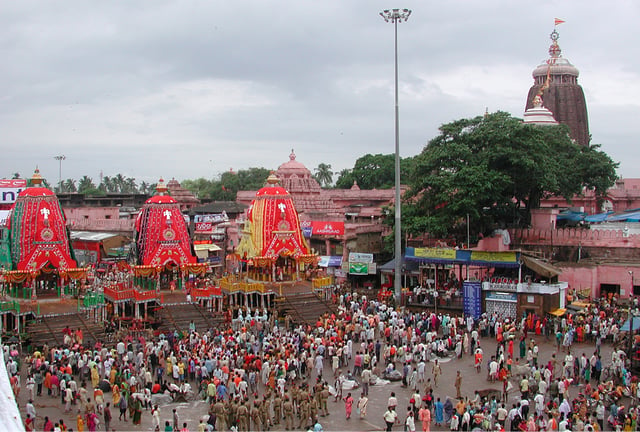
The Rath Yatra in Jagannath Temple, Puri
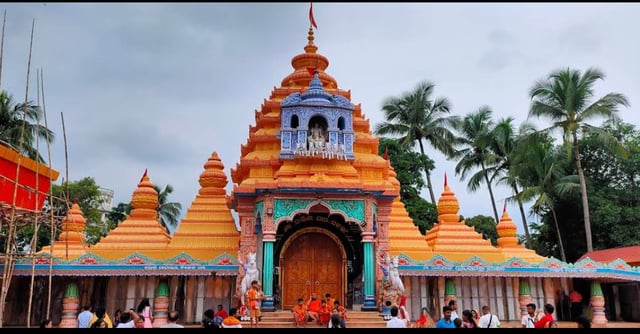
Maa tarini temple, ghatgaon
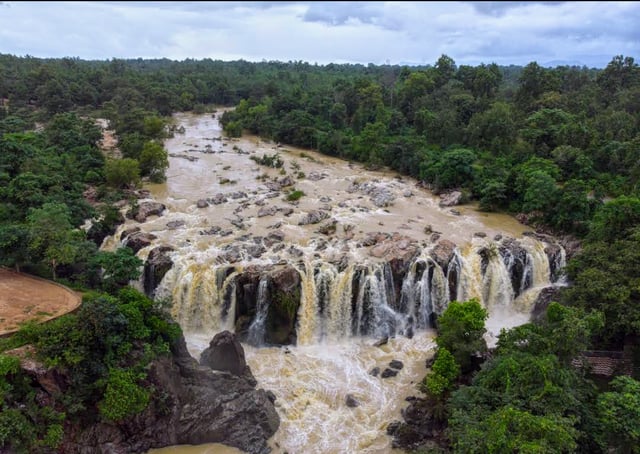
Gundichaghagi waterfall Keonjhar during monsoons
The Lingaraja Temple at Bhubaneswar has a 150-foot (46 m) high deula while the Jagannath Temple, Puri is about 200 feet (61 m) high and dominates the skyline. Only a portion of the Konark Sun Temple, the largest of the temples of the "Holy Golden Triangle" exists today, and it is still staggering in size. It stands out as a masterpiece in Odisha architecture. Sarala Temple, regarded as one of the most spiritually elevated expressions of Shaktism is in Jagatsinghpur district. It is also one of the holiest places in Odisha and a major tourist attraction. Maa Tarini Temple situated in Kendujhar district is also a famous pilgrimage destination. Every day thousands of coconuts are given to Maa Tarini by devotees for fulfilling their wishes.[120]
Odisha's varying topography – from the wooded Eastern Ghats to the fertile river basin – has proven ideal for evolution of compact and unique ecosystems. This creates treasure troves of flora and fauna that are inviting to many migratory species of birds and reptiles. Bhitarkanika National Park is famous for its second largest mangrove ecosystem. The bird sanctuary in Chilika Lake (Asia's largest brackish water lake) and the tiger reserve and waterfalls in Simlipal National Park are integral parts of eco-tourism in Odisha, arranged by Odisha Tourism.[121] Daringbadi is a hill station in the Kandhamal district of Odisha. Chandipur, a calm and serene site, is mostly unexplored by tourists. The unique specialty of this beach is the ebb tides that recede up to 4 km and tend to disappear rhythmically.
The share of foreign tourists’ arrival in the state is below one percent of total foreign tourist arrivals at all India level.[122]
See also
Bibliography of India
Cinema of Odisha
Culture of Odisha
Festivals of Odisha
Index of India-related articles
List of Odia writers
Odia literature
Odisha Government Schemes List
Odissi music
Outline of India
Western Odisha
India – Wikipedia book








